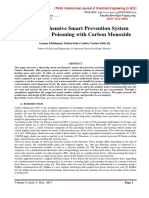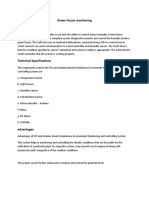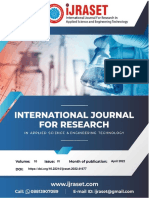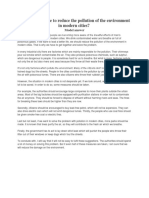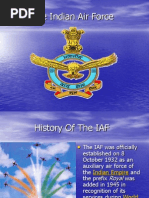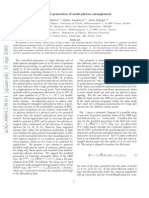Cooperative Flood Detection Using Sms Through Iot
Cooperative Flood Detection Using Sms Through Iot
Uploaded by
Anonymous 6FUcbaPCopyright:
Available Formats
Cooperative Flood Detection Using Sms Through Iot
Cooperative Flood Detection Using Sms Through Iot
Uploaded by
Anonymous 6FUcbaPOriginal Title
Copyright
Available Formats
Share this document
Did you find this document useful?
Is this content inappropriate?
Copyright:
Available Formats
Cooperative Flood Detection Using Sms Through Iot
Cooperative Flood Detection Using Sms Through Iot
Uploaded by
Anonymous 6FUcbaPCopyright:
Available Formats
ISSN (Print) : 2320 – 3765
ISSN (Online): 2278 – 8875
International Journal of Advanced Research in Electrical,
Electronics and Instrumentation Engineering
(An ISO 3297: 2007 Certified Organization)
Vol. 5, Issue 3, March 2016
Cooperative Flood Detection Using SMS
Through IoT
E.Shalini, S.Subbulakshmi, P.Surya, R.Thirumurugan
UG Student, Dept. of ECE, S.A. Engineering College, Chennai, Tamilnadu, India
UG Student, Dept. of ECE, S.A. Engineering College, Chennai, Tamilnadu, India
UG Student, Dept. of ECE, S.A. Engineering College, Chennai, Tamilnadu, India
Assistant Professor, Dept. of ECE, S.A. Engineering College, Chennai, Tamilnadu, India
ABSTRACT: Flood disaster usually happens due to improper irrigation method in a housing area or the sudden
increase of water volume in a river. Flood disaster often causes lost of property, damages and life. Since this disaster is
considered dangerous to human life, an efficient countermeasure or alert system must be implemented in order to notify
people in the early stage so that safety precautions can be taken to avoid any mishaps.This paper proposes architecture
for an early warning floods system to alert public against flood disasters. An effective early warning system must be
developed with linkages between four elements, which are accurate data collection to undertake risk assessments,
development of hazard monitoring services, communication on risk related information and existence of community
response capabilities. This project focuses on monitoring water level remotely using wireless sensor network. The
project also utilizes Global System for Mobile communication (GSM), Internet of Things(IoT) and short message
service (SMS) to relay data from sensors to computers or directly alert the respective victim's through their mobile
phone. It is hope that the proposed architecture can be further develop into a functioning system, which would be
beneficial to the community and act as a precautionary action to save lives in the case of flood disaster.
KEYWORDS: Flood detection,warning system,GSM Module,IoT,SMS.
I.INTRODUCTION
Mobile phones are vital in modern day communication these days. For communication community, mobile phones act
as a medium to communicate, interact or as a device to gain knowledge. Mobile phone is defined as a communication
device used to interact between geographical areas. There are many features available in modern mobile phones now a
day that would satisfy users. Among the most popular applications in a mobile phone is short messaging system(SMS).
SMS text messaging is the most widely used data application in the world. Based on this fact, SMS application can also
be applied to other phone of information in order to help mankind. One of the ideas is to connect a sensing system and
send an alert or warning SMS indicating any mishaps to the users. Alert SMS can be exploited to be used using a
proper system with a proper sensing system. Often cases of flood disaster happened due to residents unaware of the
sudden increase of water level at the neighborhood. Due to that a proper warning system must be implemented to notify
people in the early stage so that safety precautions can be taken to avoid any mishaps. Alert system implemented
currently is via television and radio broadcasting to indicate which area is affected. However, warnings might fail to
those affected due to ineffective and late information in the area. With the rapid development of technology, a
sustainable an reliable monitoring system is required to protect the community in any case of emergency. By implying
level sensors and GSM technology, this paper aimed to build a reliable and real time response of water level alarm
system that would detect the escalation level of water in the riverbanks and send SMS alarm to the user’s mobile phone.
SMS has been proven to be a reliable source of information recently. It also utilizes IoT, for monitoring water level
increase and controlling it remotely using wireless sensor networks. Most of the information was gathered using SMS
as the lines are congested at that moment. This shows the reliability of SMS through IoT as it works on different band
and can be used even though the lines are congested.
Copyright to IJAREEIE DOI:10.15662/IJAREEIE.2015.0503138 2099
ISSN (Print) : 2320 – 3765
ISSN (Online): 2278 – 8875
International Journal of Advanced Research in Electrical,
Electronics and Instrumentation Engineering
(An ISO 3297: 2007 Certified Organization)
Vol. 5, Issue 3, March 2016
II.SYSTEM MODEL AND ASSUMPTIONS
System structure is illustrated in Fig. 1. System composed of three sensors, one MCU-based ARMLPC2148, a GSM
module, a Wi-Fi module and a mobile phone. Sensors used are retro reflective, NPN type. It uses system of blocking
interruption where the system will give 5V signal to the amplifier. Water level sensors been used for this project due to
its unique ability of detecting water level in dams and river banks. In the water level sensor, the property of 555timer IC
is used. the temperature sensor is used for detecting the temperature level. The LM35 series is used because it generates
a higher output voltage than thermocouples and may not require the output voltage be amplified. The humidity sensor
been used for detecting moisture level in the water. If the sensor voltage exceeds the reference voltage than the
comparator gives digital logical output. MCU used is ARMLPC2148. ARMLPC2148 was chosen because it is
embedded C compiler optimized architecture. Since this project runs on embedded C compiler program, it is the best
option to use this MCU. Other special features include 512K byte flash memory that could be used to write high
capacity of programming language. GSM Module is a device used to transmit SMS signal to the intended user. By
using GSM module, GSM network can be used since it is much more accountable and by using IoT, continuous
monitoring and controlling of the water level is done.
TABLE 1 SMS CONTENTS AND CONDITIONS
CONDITIONS SMS CONTENTS
LEVEL 1 Temperature exceeded
LEVEL 2 Humidity exceeded
LEVEL 3 Water level exceeded
The working principle of the system is based on sensor’s detection shown in Table I. Level One sensor would be the
lowest part of all sensors. When Level One sensor receives a signal which means the temperature has increased more
than the threshold, the sensor would send „1‟ signal to the MCU. Upon reaching the MCU, program would identify it
as Alert trigger. Hence, MCU would send AT command of “Temperature exceeded” to GSM module. Level Two
sensor would be positioned higher than first sensor; hence the SMS display would be “Humidity exceeded‟. The
highest positioned sensor which is Level Three would send SMS of “water level exceeded‟. The system is also
monitored and controlled periodically by the Wi-Fi module. The information is stored in computer.
Copyright to IJAREEIE DOI:10.15662/IJAREEIE.2015.0503138 2100
ISSN (Print) : 2320 – 3765
ISSN (Online): 2278 – 8875
International Journal of Advanced Research in Electrical,
Electronics and Instrumentation Engineering
(An ISO 3297: 2007 Certified Organization)
Vol. 5, Issue 3, March 2016
The block diagram shows the system consists of temperature sensor, humidity sensor, water level sensor, an MCU,
GSM module, Wi-Fi module, mobile phone. The three sensors would be used for detecting the level of temperature,
humidity and water in the dams and river banks. The data send by sensors will be handled by the
MCUARM7LPC2148.
The MCU has been preprogrammed for different inputs in the three sensors and would send different output through
transmission pin. These outputs are in analog form and it is converted into digital form using ADC. Commands are
send using embedded C compiler program with relevant AT Commands. Data from the input also has been
interconnected with 2x16 character LCD to display the values of the three sensors when it is exceeded in dam or
river banks. The transmitted output from the MCU will be conveyed to GSM module and Wi-Fi module. By doing
this, SMS along would be send to respective user and by using Wi-Fi module monitoring and controlling is carried
out. User will receive different SMS depending on the level of sensors detection. GSM network is being exploited
to convey data to user via short message alarm SMS via GSM network proven to be reliable due to it works on
different band and can be sent or received although the phone lines are congested. It also as the advantage of
sending data to multiple users.
The project of the flowchart in fig 4.initial feasibility study was done to check whether the project able to fulfill the
objective to give early warning whether a flood as occurred or not. After that, embedded C program need to be
prepared for this project. Embedded C program is chosen due to the ability of the system to use AT Commands.
Once the embedded C program completed, hardware modeling is prepared for prototype purpose. Integrating
embedded C program with hardware is done to check viability of the project. During this period, any problems
encountered need to be adhered amendments must be rectified. The last step is to do analysis for the system ensure
it worked properly.
III. DESIGN OF SYSTEM HARDWARE
Prototype system had been created for this system. As mentioned above, MCU ARMLPC2148 was chosen as it is
the most common widely used MCU available the market. Besides that, it can be used with embedded C compiler
program. Embedded C compiler program was downloaded using appropriate downloader to the MCU. Three
sensors have been selected as the inputs for the system and GSM module as the output. Wi-Fi and LCD display
installed to provide indication at the control box.5v power supply used to supply voltage to the system.
IV.RESULT AND DISCUSSION
Several tests have been conducted to verify the condition of Flood detection using SMS through IoT. The tests were
conducted to accomplish the objective of the project that the system able to give SMS alert whenever the sensors
Copyright to IJAREEIE DOI:10.15662/IJAREEIE.2015.0503138 2101
ISSN (Print) : 2320 – 3765
ISSN (Online): 2278 – 8875
International Journal of Advanced Research in Electrical,
Electronics and Instrumentation Engineering
(An ISO 3297: 2007 Certified Organization)
Vol. 5, Issue 3, March 2016
detected changes of temperature, humidity and water level. The test that have been done are SMS alert receive by
the user according the user according to condition. For this test, system is tested to check whether SMS sent to user.
Sensor signal has been set using 1.5v for each signal. The system has been connected to detect signal from the
lowest sensor(Temperature sensor) and gradually to the highest sensor(water level sensor) system also has been
tested to show condition of SMS after the sensors don’t sense any changes at the sensors.
AT+CMGS=”+918765432101”
Temperature exceed
AT+CMGS=”+918765432101
Humidity exceed
AT+CMGS=”+918765432101”
Water level exceed
Figure.5.SMS TO USER
V.CONCLUSION
The project cooperative detection using SMS through IoT is deemed as a success.The project found able to be
integrated between software development and hardware design. The system able to detect increase of water level
and would send SMS alert to the respective user. System also had been tested under several conditions to check the
viability and ease of usage. The system could be placed at riverbanks, dams and drainage system. It can also be
placed in water tanks and even controlling and monitoring is carried out using IoT. The SMS alert received by the
user is an real time basis and this feature allowed user to take early preventive measures.
It is hoped that the proposed architecture can be further develop into a functioning system which could be beneficial
to the community.
REFERENCES
[1] S. Yumuang, "2001 debris flow and debris flood in Nam Ko area, Phetchabun province, central Thailand, "Environmental Geology (2006) 51:
545-564,2006.
[2] Hillebrand & Trosby, “SMS The Creation of Personal Global Text Messaging”, Wiley, 2008.
[3] H Huang S Xiao X Meng & Y Ziong, “A Remote Home Security System Based on Wireless Sensor Network and GSM Technology”, Southwest
Jiaotong University, IEEE, 2010.
[4] IA Aziz, IA Hamizan, NS Haron & M Mehat,“Cooperative Flood Detection using GSMD via SMS”, University Teknologi Petronas, IEEE, 2008.
[6] Dennis Rhody, “Satellite Communication 4th Edition”, McGraw
[7] Amnuay Tipsriraj, "Prevention of flash floods and landslides by yourself," Publication of Department of Disaster Prevention and Mitigation,
Ministry of Interior: Thailand, 2006
[8] E.Welbourne , L. Battle, G. Cole, K. Gould, K. Rector, S. Raymer et al.,“Building the Internet of things using RFID: The RFID ecosystem
experience,”IEEE Internet Comput., vol. 13, no. 3, pp. 48–55, May–Jun. 2009.
[9] N. Niu, L. Xu, and Z. Bi, “Enterprise information systems architecture analysis and evaluation,” IEEE Trans. Ind. Informat., vol.9, no.4,pp. 2147–
2154, Nov. 2013.
[10] M. Haklay, From Environmental Information Systems to Environmental Informatics: Evolution and Meaning. London, U.K.: Centre for
Advanced Spatial Analysis, Univ. College London, 1999.
[11] L.Xu, Z.Li, S.Li, and F. Tang,“A decision support system for product design in concurrent engineering,” Decis. Support Syst., vol. 42, no. 4,pp.
2029–2042, 2007.
[12] N. M. Avouris and B. Page, in Environmental Informatics: Methodology and Applications of Environmental Information Processing, B. Page,
Ed.New York, NY, USA: Springer, 1995.
[13] J. Sun, “A summary on the management of information science on natural resources,” Resour. Sci., vol. 9, no. 4, pp. 74–80, 1988.
Copyright to IJAREEIE DOI:10.15662/IJAREEIE.2015.0503138 2102
ISSN (Print) : 2320 – 3765
ISSN (Online): 2278 – 8875
International Journal of Advanced Research in Electrical,
Electronics and Instrumentation Engineering
(An ISO 3297: 2007 Certified Organization)
Vol. 5, Issue 3, March 2016
[14] J. Sun, The Spring Up of Res-Informatics and the Regional Sustainable Development Research, in the Research Corpus of Natural Resources
Explore Forty Years. Beijing, China: Chinese Science and TechnologyPress, 1996. FANG et al.:INTEGRATED SYSTEM FOR REGIONAL
ENVIRONMENTAL MONITORING AND MANAGEMENT ON IoT 1603.
[15] C. Lynch, “Big data: How do your data grow?,” Nature, vol. 455, no. 7209, pp. 28–29, 2008.
[16] H. Reuter, U. Middelhoff, F. Graef, R. Verhoeven, T. Batz, M. Weis, and B. Breckling, “Information system for monitoring environmental
impacts of genetically modified organisms,” Environ. Sci. Pollut. Res., vol. 17, no. 8, pp. 1479–1490, 2010.
[17] Y. Lin, X. Duan, C. Zhao, and L. Xu, Systems Science: Methodological Approaches. Boca Raton, FL, USA: CRC Press, 2012.
[18] H. Panetto and H. J. Cecil, “Information systems for enterprise integration, interoperability and networking: Theory and applications,” Enterp.
Inf.Syst., vol. 7, no. 1, pp. 1–6, 2013.
[19] S. Fang, L. Xu, H. Pei, Y. Liu, Z. Liu, Y. Zhu et al., “An integrated approach to snowmelt flood forecasting in water resource management,”
IEEE Trans. Ind. Informat., vol. 10, no. 1, pp. 548–558, Apr. 2013.
[20] R. Yuan, Z. Li, X. Guan, and L. Xu, “An SVM-based machine learning method for accurate Internet traffic classification,” Inf. Syst. Front., vol.
12, no. 2, pp. 149–156, 2010.
[21] N. P.Melville, “Information systems innovation for environmental sustainability,” MIS Quart., vol. 34, no. 1, pp. 1–21, 2010.
[22] L. Xu, “Enterprise systems: State-of-the-art and future trends,” IEEE Trans. Ind. Informat., vol. 7, no. 4, pp. 630–640, Nov. 2011.
[23] H. Hassan, J. Martinez-Rubio, A.Perles, J. Capella, C.Dominguez and J.Albaladejo, “Smartphone-based industrial informatics projects
andlaboratories,”IEEETrans.Ind.Informat.,vol.9, no. 1,pp.557–566,Feb.2013.
[24] J. Ulmer, J.Belaud, and J. Le Lann, “A pivotal-based approach for enterprise business process and IS integration,” Enterp. Inf. Syst., vol. 7, no.
1, pp. 61–78, 2013.
[25] X. Gao, L. Xu, X. Wang, Y. Li, M. Yang, and Y. Liu, “Workflow process modelling and resource allocation based on polychromatic sets
theory,”
Enterp. Inf. Syst., vol. 7, no. 2, pp. 198–226, 2013.
[26] L. Duan and L. Xu, “Business intelligence for enterprise systems: A survey,” IEEE Trans. Ind. Informat., vol. 8, no. 3, pp. 679–687, Aug. 2012.
[27] L. Xu, “Information architecture for supply chain quality management,” Int.J. Prod. Res., vol. 49, no. 1, pp. 183–198, 2011.
[28] X. Gao, L. Xu, X. Wang, Y. Li, M. Yang, and Y. Liu, “Workflow process modelling and resource allocation based on polychromatic sets
theory,”
Enterp. Inf. Syst., vol. 7, no. 2, pp. 198–226, 2013.
[29] L. Xu, N. Liang, and G. Qiong, “An integrated approach for agricultural ecosystem management,” IEEE Trans. Syst. Man Cybern. C, Appl.
Rev.,
vol. 38, no. 4, pp. 590–599, Jul. 2008.
[30] L. Li, L. Xu, H. A. Jeng, D. Naik, T. Allen, and M. Frontini, “Creation of environmental health information system for public health service: A
pilot study,” Inf. Syst. Front., vol. 10, no. 5, pp. 531–542, 2008.
[31] S. Li, L. Xu, and X. Wang, “A continuous biomedical signal acquisition system based on compressed sensing in body sensor networks,”
IEEETrans. Ind. Informat., vol. 9, no. 3, pp. 1764–1771, Aug. 2013.
[32]E.Xu,M.Wermus,andD.B.Bauman, “Development of an integrated medical supply information system,” Enterp. Inf. Syst., vol. 5, no.3,pp. 385–
399, 2011.
[33] L.Xu, C.Wang, X.Luo, and Z. Shi, “Integrating knowledge management and ERP in enterprise information systems,” Syst. Res. Behav. Sci., vol.
23, no. 2, pp. 147–156, 2006.
[34] L.Xu, C.Wang, Z Bi, and J. Yu, “Auto Assem : An automated assembly planning system for complex products,” IEEE Trans. Ind. In format.,
vol. 8, no. 3, pp. 669–678, Aug. 2012.
[35] L. D. Xu, C. Wang, Z. Bi, and J. Yu, “Object-oriented templates for automated assembly planning of complex products,” IEEE
Trans.Autom.Sci.
Copyright to IJAREEIE DOI:10.15662/IJAREEIE.2015.0503138 2103
You might also like
- List of Companies PDFDocument22 pagesList of Companies PDFAnaoj2891% (11)
- Study On Intelligent Automatic Vehicle Accident Prevention and Detection SystemDocument5 pagesStudy On Intelligent Automatic Vehicle Accident Prevention and Detection Systemvalchuks2k1No ratings yet
- Ijece - Sewage Block Identification and Rescue System Using Wireless Sensor - 1Document6 pagesIjece - Sewage Block Identification and Rescue System Using Wireless Sensor - 1iaset123No ratings yet
- A Novel Approach of Power-Line Monitoring System Using Iot: Sudharshan Duth. P, Anirudh A. Kodagali & G. Harish SinghDocument8 pagesA Novel Approach of Power-Line Monitoring System Using Iot: Sudharshan Duth. P, Anirudh A. Kodagali & G. Harish SinghTJPRC PublicationsNo ratings yet
- IoT Based Flood Monitoring and Alerting System Ijariie19486Document9 pagesIoT Based Flood Monitoring and Alerting System Ijariie19486coch88666No ratings yet
- Iot Technology Based Underground Cable Fault Distance Detection System Using Atmega328P MicrocontrollerDocument11 pagesIot Technology Based Underground Cable Fault Distance Detection System Using Atmega328P MicrocontrollerLaxmi jambagiNo ratings yet
- IJSDR2003046Document5 pagesIJSDR2003046tamannakouser1812No ratings yet
- Paper 11271Document4 pagesPaper 11271paulo soaresNo ratings yet
- Landslide Warning System Using Wireless Sensor NetworkDocument5 pagesLandslide Warning System Using Wireless Sensor NetworkInternational Journal of Application or Innovation in Engineering & ManagementNo ratings yet
- IoT Based Smart Sewage Monitoring System Using GSM and Wi-Fi ModuleDocument4 pagesIoT Based Smart Sewage Monitoring System Using GSM and Wi-Fi ModuleInternational Journal of Innovative Science and Research TechnologyNo ratings yet
- IOT BASED EARLY FLOOD MONITORIN DETECTION AND ALARMING SYSTEM Ijariie11894Document8 pagesIOT BASED EARLY FLOOD MONITORIN DETECTION AND ALARMING SYSTEM Ijariie11894prasaath VRNo ratings yet
- Automatic Fire Detection Using GSM and Image ProcessingDocument5 pagesAutomatic Fire Detection Using GSM and Image ProcessingPriyadharshiniNo ratings yet
- Air Pollution Monitoring SystemDocument5 pagesAir Pollution Monitoring SystemEditor IJTSRDNo ratings yet
- Powerline Monitoring System Using Iot - A Review: Sudharshan Duth. P, G. Harish Singh & Anirudh A. KodagaliDocument4 pagesPowerline Monitoring System Using Iot - A Review: Sudharshan Duth. P, G. Harish Singh & Anirudh A. KodagaliTJPRC PublicationsNo ratings yet
- JETIR2210284Document4 pagesJETIR2210284nisha sharmsNo ratings yet
- Embedded Weather Station With Remote Wireless ControlDocument4 pagesEmbedded Weather Station With Remote Wireless Controlwahyuthp43100% (1)
- EC 030.reportDocument27 pagesEC 030.reportdamunali08No ratings yet
- LORA Water MonitoringDocument10 pagesLORA Water MonitoringPhuc HoangNo ratings yet
- Iot Based Weather Station: A Minor Project ReportDocument7 pagesIot Based Weather Station: A Minor Project ReportAjay TendulkarNo ratings yet
- Monitoring of Electrical System Using Internet of Things With Smart Current Electric SensorsDocument8 pagesMonitoring of Electrical System Using Internet of Things With Smart Current Electric SensorsMarcela VelasteguíNo ratings yet
- Solar Power Control & Monitoring Using Iot & Automatic Stret Light ControlDocument6 pagesSolar Power Control & Monitoring Using Iot & Automatic Stret Light ControlNusrat NehaNo ratings yet
- ARM Based Automatic Critical Health Care Service System Using Wireless CommunicationDocument7 pagesARM Based Automatic Critical Health Care Service System Using Wireless CommunicationjormnNo ratings yet
- Aurdino Based Automatic Plant Watering System With Internet of ThingsDocument8 pagesAurdino Based Automatic Plant Watering System With Internet of ThingsAanam FathimaNo ratings yet
- Design of A Novel Iot Based Cardiovascular Patient Health and Surrounding Weather Monitoring and Controlling SystemDocument10 pagesDesign of A Novel Iot Based Cardiovascular Patient Health and Surrounding Weather Monitoring and Controlling SystemLeslie MedinaNo ratings yet
- Survey On WSN Based Weather Monitoring by Using IOTDocument6 pagesSurvey On WSN Based Weather Monitoring by Using IOTallaga sunggyu 22No ratings yet
- Industrial Sewage Water Quality Monitoring SystemDocument8 pagesIndustrial Sewage Water Quality Monitoring SystemAvinash ChikhalkarNo ratings yet
- Water Monitoring System Based On GSM: IarjsetDocument4 pagesWater Monitoring System Based On GSM: IarjsetxperiaashNo ratings yet
- A Comprehensive Smart Prevention System Against Home Poisoning With Carbon MonoxideDocument9 pagesA Comprehensive Smart Prevention System Against Home Poisoning With Carbon MonoxideInternational Journal of Application or Innovation in Engineering & ManagementNo ratings yet
- Anti Smugg Jounral PaperDocument6 pagesAnti Smugg Jounral PaperAlexsanderNo ratings yet
- IOT Based Harmful Gases Level Detection System For Underground SewagesDocument8 pagesIOT Based Harmful Gases Level Detection System For Underground SewagessandeepNo ratings yet
- 39 - Batch 39Document5 pages39 - Batch 39DHINESHKUMAR MNo ratings yet
- IJRAR23B2841-Iot Based Leakge Current DetectorDocument5 pagesIJRAR23B2841-Iot Based Leakge Current DetectorHarsh PandeNo ratings yet
- K.S.R College of EngineeringDocument19 pagesK.S.R College of EngineeringKarthick Venkat04121998No ratings yet
- Chapter 2sDocument7 pagesChapter 2sshheshh heesNo ratings yet
- Irrigation RRLDocument6 pagesIrrigation RRLErica May ReyesNo ratings yet
- Partial Discharge Ultraviolet Detection Technology Applied N Enclosed High-Voltage Electrical AppliancesDocument4 pagesPartial Discharge Ultraviolet Detection Technology Applied N Enclosed High-Voltage Electrical AppliancesbabakfazelNo ratings yet
- Air and Sound Pollution Monitoring System Using IoTDocument4 pagesAir and Sound Pollution Monitoring System Using IoTEditor IJRITCC0% (1)
- Early Flood Detection Group No 22CO301Document20 pagesEarly Flood Detection Group No 22CO301Rutuja IngaleNo ratings yet
- An Iot Based Farm Management Using Image Processing: A.Jabeena, G.Suresh, S.Swathi, K.AbinayaDocument6 pagesAn Iot Based Farm Management Using Image Processing: A.Jabeena, G.Suresh, S.Swathi, K.AbinayaJabeena AfthabNo ratings yet
- Iot Based Smart Irrigation SystemDocument5 pagesIot Based Smart Irrigation SystemReddy RNo ratings yet
- Wireless Information Display System With Audio Using GSM and Arduino (Atmega328P-Pu)Document4 pagesWireless Information Display System With Audio Using GSM and Arduino (Atmega328P-Pu)kiran vemulaNo ratings yet
- Es 3455018319Document5 pagesEs 3455018319lafiy25867No ratings yet
- Iot - Based - Train - Accident - and - Location - Tracking - SystemDocument5 pagesIot - Based - Train - Accident - and - Location - Tracking - Systemmai.sangNo ratings yet
- Automated System Design For Metro Train Using Wireless Sensor NetworkDocument6 pagesAutomated System Design For Metro Train Using Wireless Sensor Networkharshit devillersNo ratings yet
- IOT Based Flood Monitoring and Alerting SystemDocument9 pagesIOT Based Flood Monitoring and Alerting SystemIJRASETPublicationsNo ratings yet
- 2K20 - SYS - IOT BASEDFLOOD CROP LOSS PREDICTION, ASSESSMENT AND EVIDENCE COLLECTION (1) UpdatedDocument13 pages2K20 - SYS - IOT BASEDFLOOD CROP LOSS PREDICTION, ASSESSMENT AND EVIDENCE COLLECTION (1) UpdatedAqeel AhmedNo ratings yet
- Points Green HouseDocument6 pagesPoints Green HouseAjay TiwariNo ratings yet
- IOT Based Diagnosing of Fault Detection in Power Line Distribution Using ArduinoDocument6 pagesIOT Based Diagnosing of Fault Detection in Power Line Distribution Using ArduinoTolesa ShoreNo ratings yet
- 8 RaspberryDocument10 pages8 RaspberryMuhammad ToyeebNo ratings yet
- IOT Based Wether Monitoring System Using Blink AppDocument31 pagesIOT Based Wether Monitoring System Using Blink Appsuresh p100% (2)
- Real Time Forest Anti-Smuggling Monitoring System Based On IOT Using GSMDocument7 pagesReal Time Forest Anti-Smuggling Monitoring System Based On IOT Using GSMRaksha RagavendranNo ratings yet
- Health Safety of Sewage WorkrsDocument8 pagesHealth Safety of Sewage WorkrsRAJESH KUMARNo ratings yet
- A Review On Manhole Monitoring SystemDocument6 pagesA Review On Manhole Monitoring SystemIJRASETPublicationsNo ratings yet
- IJSDR2304251Document9 pagesIJSDR2304251Pranav HuilgolNo ratings yet
- Iot Based Flood Monitoring and Controlling SystemDocument9 pagesIot Based Flood Monitoring and Controlling SystemAnisha Arya AryaNo ratings yet
- Natural DisasterDocument12 pagesNatural Disasterashreekar767No ratings yet
- Fluid Level Controller and Detector: April 2015Document6 pagesFluid Level Controller and Detector: April 2015Lay ShahNo ratings yet
- Android Controlled Notice Board: Prof. Neha TiwariDocument4 pagesAndroid Controlled Notice Board: Prof. Neha TiwariNayan SolanKiNo ratings yet
- IoT Based Substation Monitoring and ControlDocument8 pagesIoT Based Substation Monitoring and ControlIJRASETPublicationsNo ratings yet
- Multichannel Data Acquisition SystemDocument11 pagesMultichannel Data Acquisition SystemIJRASETPublicationsNo ratings yet
- DR Ahmad Zairy PDFDocument25 pagesDR Ahmad Zairy PDFAnonymous 6FUcbaPNo ratings yet
- Bank BumiputeraDocument25 pagesBank BumiputeraAnonymous 6FUcbaPNo ratings yet
- PID 223 pp117 135Document19 pagesPID 223 pp117 135Anonymous 6FUcbaPNo ratings yet
- What Can Be Done To Reduce The Pollution of The Environment in Modern CitiesDocument1 pageWhat Can Be Done To Reduce The Pollution of The Environment in Modern CitiesAnonymous 6FUcbaPNo ratings yet
- Concept of Environmental Sustainability Awareness Strategies in Pre-Construction StageDocument14 pagesConcept of Environmental Sustainability Awareness Strategies in Pre-Construction StageAnonymous 6FUcbaPNo ratings yet
- Theeranaipunya 2 Livi WilsonDocument5 pagesTheeranaipunya 2 Livi WilsonAnonymous 6FUcbaPNo ratings yet
- What Can Be Done To Reduce The Pollution of The Environment in Modern CitiesDocument1 pageWhat Can Be Done To Reduce The Pollution of The Environment in Modern CitiesAnonymous 6FUcbaPNo ratings yet
- Understanding Social Communication in The Work PlaceDocument3 pagesUnderstanding Social Communication in The Work PlaceAnonymous 6FUcbaP100% (1)
- What Are The Recommended Strategies To Use To Improve Customer SatisfactionDocument4 pagesWhat Are The Recommended Strategies To Use To Improve Customer SatisfactionAnonymous 6FUcbaPNo ratings yet
- Komunikasi Antar Budaya: Reza Praditya Yudha, M.I.KomDocument25 pagesKomunikasi Antar Budaya: Reza Praditya Yudha, M.I.KomAnonymous 6FUcbaPNo ratings yet
- Positive ThinkingDocument3 pagesPositive ThinkingAnonymous 6FUcbaPNo ratings yet
- Solutionsdemos and Videosknowledge Centerrequest A Demoabout UsDocument34 pagesSolutionsdemos and Videosknowledge Centerrequest A Demoabout UsAnonymous 6FUcbaPNo ratings yet
- The Effect of Service Quality and CustomDocument62 pagesThe Effect of Service Quality and CustomAnonymous 6FUcbaPNo ratings yet
- Development of Portable Water Level Sensor For Flood Management SystemDocument6 pagesDevelopment of Portable Water Level Sensor For Flood Management SystemAnonymous 6FUcbaPNo ratings yet
- Consumer Customer and Perceived Value 1939 6104 17-4-248Document9 pagesConsumer Customer and Perceived Value 1939 6104 17-4-248Anonymous 6FUcbaPNo ratings yet
- School SpeechDocument4 pagesSchool SpeechAnonymous 6FUcbaPNo ratings yet
- BAB 1 BANJIR PmbetulanDocument5 pagesBAB 1 BANJIR PmbetulanAnonymous 6FUcbaPNo ratings yet
- Illustrated Parts Catalog FOR IO-346 Aircraft EnginesDocument32 pagesIllustrated Parts Catalog FOR IO-346 Aircraft Enginesr4airsalvageNo ratings yet
- Paper VHDLDocument20 pagesPaper VHDLSanchit SaxenaNo ratings yet
- My 1306 1300 EDi Genset - Data List - 2Document1 pageMy 1306 1300 EDi Genset - Data List - 2Khaled Kamel100% (1)
- The Indian Air ForceDocument27 pagesThe Indian Air ForceSakshi SirawaleNo ratings yet
- UGCguidlinesDocument13 pagesUGCguidlinesAkesh KumarNo ratings yet
- Standing GuardDocument24 pagesStanding Guardtutorial 001No ratings yet
- دليل الأمومة (Mama Care) -2017 PDFDocument66 pagesدليل الأمومة (Mama Care) -2017 PDFsojoud shorbajiNo ratings yet
- Brochure Bane Nor - We Create The Railway of The Future PDFDocument17 pagesBrochure Bane Nor - We Create The Railway of The Future PDFDiego García VaqueroNo ratings yet
- t7 888Document5 pagest7 888Shovan DeyNo ratings yet
- Mathematics Paper 2 Year 5 Answer All Questions - Answer Are To Be Written in The Spaces Provided On The Question PaperDocument4 pagesMathematics Paper 2 Year 5 Answer All Questions - Answer Are To Be Written in The Spaces Provided On The Question PapernarmataNo ratings yet
- MNPTP - 01 - 8-16A Ton IntroductionDocument20 pagesMNPTP - 01 - 8-16A Ton IntroductionGlobal Teknik Abadi100% (1)
- Neolithic RevolutionDocument15 pagesNeolithic RevolutionSara Morales VillavicencioNo ratings yet
- RefinedDocument2 pagesRefinedminh nguyenNo ratings yet
- Wangsit TPS JeroanayamDocument364 pagesWangsit TPS JeroanayamWisga Putra100% (1)
- What Is TPACK FrameworkDocument17 pagesWhat Is TPACK FrameworkMay Teologo DomingoNo ratings yet
- Answer Key Business Economics-IIDocument3 pagesAnswer Key Business Economics-IISunni ZaraNo ratings yet
- ZETOR Forterra 95-125 Operator ManualDocument197 pagesZETOR Forterra 95-125 Operator ManualtropicalpetsfoodNo ratings yet
- Tejass Challenge 2 English For Communication Form 1 Special EducationDocument5 pagesTejass Challenge 2 English For Communication Form 1 Special EducationMuhd AfiqNo ratings yet
- Final May 2024Document4 pagesFinal May 2024ggNo ratings yet
- Az-900 Mock 9Document5 pagesAz-900 Mock 9rparth152No ratings yet
- BioJava BookDocument101 pagesBioJava BookrednriNo ratings yet
- Coa Circular 2005-Oo2Document2 pagesCoa Circular 2005-Oo2retep69phNo ratings yet
- Heralded Generation of Multi-Photon EntanglementDocument4 pagesHeralded Generation of Multi-Photon EntanglementsyedfaiziNo ratings yet
- Basic Hacking Techniques PDFDocument60 pagesBasic Hacking Techniques PDFKO NINo ratings yet
- Recipe For Making SwarmaDocument3 pagesRecipe For Making SwarmaDonald GonsalvesNo ratings yet
- U1 CreatingWebsiteBasicsUsingHTMLDocument13 pagesU1 CreatingWebsiteBasicsUsingHTMLSherril VincentNo ratings yet
- Ba dr4310Document2 pagesBa dr4310BaoLCNo ratings yet
- Charles Ray - ArtforumDocument5 pagesCharles Ray - ArtforumWagner LouzaNo ratings yet
- T4 MemoryDocument24 pagesT4 Memorycosmicmarker92No ratings yet



























